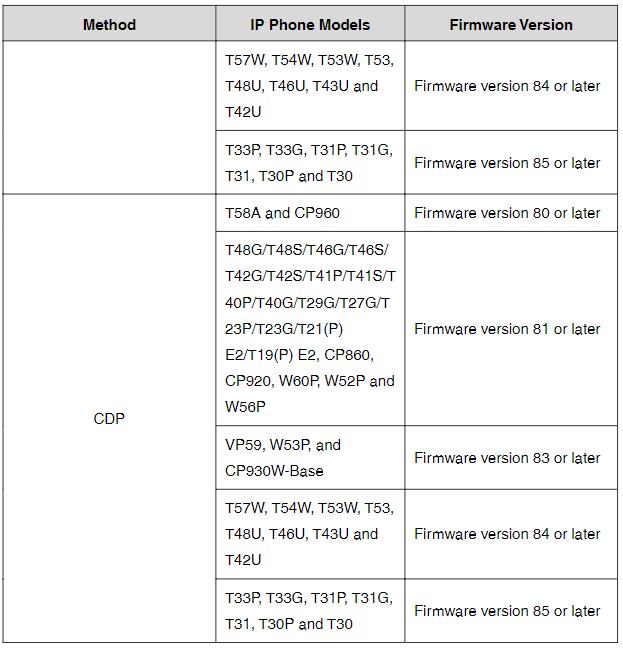VLAN-optie voor IP-telefoon
Yealink Telefoon VLAN-functie



VLAN's bieden veel voordelen die niet in typische LAN's voorkomen. De belangrijkste voordelen van het scheiden van IP-telefoons in VLAN(s) worden hieronder opgesomd:
Prestatieverbeteringen: VLAN wordt gebruikt om het broadcastdomein te minimaliseren. Het creëren van een kleiner domein voor IP-telefoons kan overhead verminderen en resourcegebruik beperken. Bovendien hoeft er minder verkeer te worden gerouteerd en wordt de latentie die door routers wordt toegevoegd, verminderd.
Gemakkelijk te beheren: Veel van de kosten die gepaard gaan met netwerkuitbreidingen en -verplaatsingen kunnen worden bespaard door het gebruik van VLAN's. IP-telefoons kunnen van de ene werkgroep of afdeling naar de andere worden verplaatst zonder nieuwe netwerkbekabeling te installeren en hubs of routers opnieuw te configureren.
Beveiliging: VLAN's kunnen worden gebruikt om beveiligde gebruikersgroepen te maken en te voorkomen dat anderen buiten het broadcastdomein gevoelige gegevens van de IP-telefoon ontvangen. Ze kunnen ook worden gebruikt om firewallfuncties te verbeteren en netwerktoegang voor een of meer gebruikers te beperken. Door IP-telefoons in VLAN's te scheiden, kunnen beveiligingsfilters in het netwerk worden geïmplementeerd om te voorkomen dat de IP-telefoons onnodig verkeer van andere apparaten ontvangen. Dit helpt verstoring door DoS-aanvallen of probeert de apparaten te compromitteren. Het staat ook toe om de toegang tot de configuratie en servers te blokkeren, zodat alleen toegang vanaf de IP-telefoons mogelijk is.
Er zijn vier manieren om VLANID voor internet (WAN) poort te verkrijgen, maar de gebruikte VLAN wordt gekozen door de prioriteit van elke methode (van hoog naar laag): LLDP/CDP>Handmatig>DHCPVLAN. Er is maar één manier om VLAN ID voor PC poort te verkrijgen: Handmatig. Yealink SIP VP-T49G IP telefoons ondersteunen VLAN in het draadloze netwerk. De methode die de telefoons gebruiken om VLAN ID in het draadloze netwerk te verkrijgen is dezelfde als die in het bekabelde netwerk.
Opmerking
LLDP- en CDP-methoden hebben dezelfde prioriteit om VLAN-ID te verkrijgen. Normaal gesproken is de VLAN-ID die voor de IP-telefoon wordt verkregen via LLDP- en CDP-methoden hetzelfde.
In de onderstaande tabel staan de methoden die worden ondersteund door Yealink SIP IP-telefoons met verschillende versies.


Automatische detectiemethode voor VLAN
LLDP-introductie
LLDP (Link Layer Discovery Protocol) staat IP-telefoons toe om apparaatgerelateerde informatie te ontvangen en/of te verzenden naar direct verbonden apparaten op het netwerk die ook het protocol gebruiken, en de informatie op te slaan die over andere apparaten wordt geleerd. Informatie verzameld met LLDP wordt opgeslagen in het apparaat als een managementinformatiedatabase (MIB) en kan worden opgevraagd met het Simple Network Management Protocol (SNMP) zoals gespecificeerd in RFC 2922. LLDP verzendt de informatie als pakketten die LLDP Data Units (LLDPDU's) worden genoemd. Een LLDPDU bestaat uit een set Type-Length-Value (TLV)-elementen, die elk een bepaald type informatie bevatten over het apparaat of de poort die het verzendt.
Elk van de TLV-componenten heeft de volgende basisstructuur:

Verplichte LLDP TLV's: Chassis-ID, poort-ID en Time to Live (TTL) zijn standaard opgenomen in een LLDPDU.
Optionele LLDP TLV's: Systeemnaam, systeembeschrijving, enzovoort. De telefoon verstuurt de optionele TLV's samen met de verplichte TLV's in een LLDPDU.
Organisatiespecifieke TLV's: MAC/PHY-configuratie/status en poort-VLAN-ID, die respectievelijk zijn gedefinieerd in de IEEE-standaard 802.3 en 802.1. Het LLDP-frame eindigt met een speciale TLV, genaamd end of LLDPDU, waarin zowel de type- als de length-velden 0 zijn.
LLDP-MED (Media Endpoint Discovery) wordt gepubliceerd door de Telecommunications Industry Association (TIA). Het is een uitbreiding op LLDP die werkt tussen eindpuntapparaten en netwerkconnectiviteitsapparaten. LLDP-MED biedt specifiek ondersteuning voor voice over IP (VoIP)-toepassingen en biedt de volgende mogelijkheden:
Capabilities Discovery: hiermee kunnen LLDP-MED-eindpunten de mogelijkheden bepalen die het aangesloten apparaat ondersteunt en heeft ingeschakeld. Dit kan worden gebruikt om aan te geven of het aangesloten apparaat een telefoon, een switch, een repeater, enz. is.
Configuratie van spraak-VLAN: biedt een mechanisme waarmee een switch een apparaat kan laten weten welk VLAN moet worden gebruikt, waardoor 'plug and play'-netwerken mogelijk worden.
Energiebeheer: biedt informatie over de manier waarop het apparaat van stroom wordt voorzien, de energieprioriteit en hoeveel stroom het apparaat nodig heeft.
Voorraadbeheer: biedt een manier om apparaten en de kenmerken van het apparaat, zoals modelnummer, serienummer, softwareversie, enz. te beheren.
Locatie-identificatiedetectie: geeft locatie-informatie van de schakelaar door aan het apparaat wanneer u een noodoproep plaatst.
LLDP-MED-mogelijkheden TLV
Netwerkbeleid TLV
Energiebeheer TLV
Voorraadbeheer TLV
Locatie-identificatie TLV (niet ondersteund door IP-telefoons)
Opgemerkt dient te worden dat zowel LLDP als LLDP-MED (maar niet beide) op elk willekeurig moment op een interface tussen twee apparaten gebruikt kunnen worden.
LLDP biedt uitzonderlijke interoperabiliteitsvoordelen, probleemoplossing voor IP-telefonie, automatische implementatie van beleid en geavanceerde PoE (Power over Ethernet). Wanneer de LLDP-functie is ingeschakeld op IP-telefoons, adverteren de IP-telefoons periodiek hun eigen informatie naar de direct aangesloten LLDP-switch. De IP-telefoons kunnen ook LLDP-pakketten ontvangen van de aangesloten switch. Wanneer het toepassingstype "spraak" is, beslissen IP-telefoons of de VLAN-configuraties die zijn verkregen uit de LLDP-pakketten, moeten worden bijgewerkt. Wanneer de VLAN-configuraties op de IP-telefoons verschillen van de configuraties die door de switch worden verzonden, voeren de IP-telefoons een update uit en starten ze opnieuw op. Hierdoor kunnen de IP-telefoons op elke switch worden aangesloten, hun VLAN-ID's verkrijgen en vervolgens communicatie starten met de oproepcontrole.
Ondersteunde TLV's van IP-telefoons
De TLV's die door IP-telefoons worden ondersteund, worden in de volgende tabel samengevat:
...
PDF downloaden: Klik hier >

Kosteneffectieve Wi-Fi IP-telefoonoplossing

Draadloos bereik van ongeveer 50 meter binnenshuis en tot 300 meter buitenshuis

Professioneel robuust telefoonsysteem voor uitdagende omgevingen

Elite desktoptelefoon voor managers en professionals

HD IP-conferentietelefoon voor onderweg en in overlegruimtes

Een veelzijdige kantoor telefoon en een voordelige WiFi IP telefoon
Neem contact met ons op
Neem contact met ons op voor productoffertes en installatieconsultaties. Wij zullen onmiddellijk een lokale dealer op de hoogte stellen om u nauwkeurige en efficiënte serviceoplossingen te bieden.







